|
|
Musical Offering BWV 1079
Bach’s Musical Offering
|
1 |
J.S. Bach: Offrande Musicale |
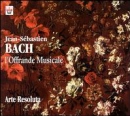
|
|
Musical Offering BWV 1079 [49:28] |
|
- |
|
Arte Resoluta |
|
Lorenzo Brondetta (Flauto Traverso); Renata Spotti (Violin); Ben Sansom (Violin & Viola); Giovanna Barbati (Cello); Fabio Bonizzoni (Harpsichord & Organ) |
|
Arion |
Jul 1999 |
CD / TT: 49:28 |
|
Recorded at Mantoue, Italy.
Buy this album at: Amazon.com |
|
4 |
J.S. Bach: Musikalisches Opfer · Musical Offering BWV
1079 [A-2] |
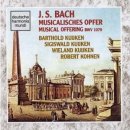
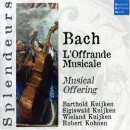 |
|
Musical Offering BWV 1079
[49:15] |
|
- |
|
Kuijken Brothers |
|
Barthold Kuijken (Transverse Flute); Sigiswald
Kuijken (Violin); Wieland Kuijken (Bass Viol); Robert
Kohnen (Harpsichord) |
|
Deutsche Harmonia Mundi |
Feb 22-25, 1994 |
CD / TT: 49:15 |
|
Recorded at Doopsgezindekerk, Haarlem, the Netherlands.
2nd recording of Musical Offering BWV 1079 by Kuijken
Brothers.
Buy this album at:
CD: Amazon.com
| Amazon.com |
|
6 |
J.S. Bach: A Musical Offering [A-1] |
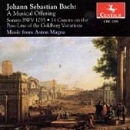
|
|
Musical Offering BWV 1079 [44:00] |
|
Daniel Stepner (Director) |
|
Music from Aston Magna |
|
Daniel Stepner (Violin) [23]; Linda Quan (Violin [2], Viola [3]); Laura Jeppesen (Viola da gamba) [1-3]; Christopher Krueger (Baroque Flute) [1-3]; John Gibbons (Fortepiano) [1-3] |
|
Centaur |
Jul 1995 |
CD / TT: |
|
Recorded at Campion Center, Weston, Massachusetts, USA |
|
8 |
Bach: Die Kunst der Fugue (The Art of Fugue) [K-13] |
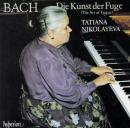
|
|
2 Ricercari from Musical Offering BWV 1079 [16:40] |
|
Tatiana Nikolayeva (Piano) |
|
Hyperion |
Jan 22-28, 1992 |
2-CD / TT: 122:15 |
|
2nd recording of Ricercar No. 1 from Musical Offering BWV 1079 by T. Nikolayeva.
Buy this album at: Amazon.com |
|
9 |
J.S. Bach: A Musical Offering |
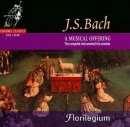
|
|
Musical Offering BWV 1079: Ricercar à 6 & Trio Sonata []
Trio Sonatas BWV 1037-1039 |
|
- |
|
Florilegium Musicum Ensemble |
|
Rachel Podger (Violin & Viola); Lucy Russell (Violin); Daniel Yeadon (Cello & Viola da gamba); Ashley Solomon (Flute & Recorder); Andrew Crawford (Flute); Neal Peres da Costa (Harpsichord & Organ) |
|
Channel Classics |
Mar 1998 |
CD / TT: 58:51 |
|
Recorded at St. Martin's Church, East Woodhay, UK. Trio Sonatas constitute the remainder of the disc's playing time.
Buy this album at: Amazon.com |
|
Part 1 |
|
Donald Satz wrote (March 30, 2001):
In May of 1747, Bach was visiting Frederick II, the King of Prussia. Frederick played a theme for Bach in C minor which the King himself reportedly composed. After listening to Fredplay the theme, Bach promised to compose a set of variations on the theme for Frederick; it's good to keep Frederick happy. So, Bach did his composing and the results were sent to Berlin from Leipzig. Unfortunately, these results were sent in random order. Hence, there has always been quite a bit of debate and research as to the correct order of the Musical Offering BWV 1079.
It's reasonable to say that Bach's Musical Offering consists of 16 movements, assuming that each movement of the trio sonata is counted as 1. But what order to use? There are two Ricercari, and noted scholar Ursula Kirkendale reconstructed the work by breaking it down into two sections with each Ricercar introducing a section. I like this reconstruction and will review the Musical Offering using its order.
The following recordings are provided for your consideration:
[1] Arte Resoluta - Arion 68526 (2000) - Renata Spotti on violin, Ben Sansom on violin & viola, Lorenzo Brondetta on flauto traverso, Giovanna Barbati on cello, and Fabio Bonizzoni on harpsichord & organ.
[2] Gustav Leonhardt, Director - Pro Arte 009 (1974) - Sigiswald Kuijken & Marie Leonhardt on violin, Wieland Kuijken on viola da gamba, Barthold Kuijken on flauto traverso, and Robert Kohnen & Gustav Leonhardt on harpsichord.
[3] Harmonia Mundi 2951260 (1987) - John Holloway on violin, Jaap ter Linden on cello, Janet See on flauto traverso, and Davitt Moroney & Martha Cook on harpsichord.
[4] Deutsche Harmonia Mundi 77307 (1994) - Sigiswald Kuijken on violin, Wieland Kuijken on viola da gamba, Barthold Kuijken on flauto traverso, and Robert Kohnen on harpsichord.
[5] Ensemble Sonnerie - Virgin 45139 (1994) - Monica Huggett on violin, Sarah Cunningham on viola da gamba, Pavlo Beznosiuk on violin & viola, Wilbert Hazelzet on flute, Paul Goodwin on various oboes, Frances Eustace on bassoon, and Gary Cooper on harpsichord.
[6] Music from Aston Magna, Daniel Stepner Directing - Centaur 2295 (1995) - Daniel Stepner & Linda Quan on violins & violas, Laura Jeppesen on viola da gamba, Christopher Krueger on baroque flute, and John Gibbons on fortepiano.
[7] Hänssler 92133 (1999) - Gottfried von der Goltz & Martin Jopp on violin, Ekkehard Weber on viola da gamba, Karl Kaiser on flute, and Michael Behringer on harpsichord and fortepiano.
[8] Tatiana Nikolayeva - Hyperion 66631/2 (1992) - The two Ricercari coupled with Art of Fugue and the Four Duets.
[9] Florilegium - Channel Classics 14598 (2000) - Ricercar A 6 & trio sonata from Musical Offering coupled with Trio Sonatas BWV 1037 thru 1039 - Rachel Podger on violin and viola, Lucy Russell on violin, Daniel Yeadon on cello and viola da gamba, Ashley Solomon on flute and recorder, Andrew Crawford on flute, and Neal Peres da Costa on harpsichord and organ. Trio Sonatas constitute the remainder of the disc's playing time.
[10] The above recordings are essentially complete except for Nikolayeva and Florilegium. I am including these two for performances I have thought very highly of in the past and definitely want to listen to again.
The Ricercar A 3 has fugal passages which are built on improvisatory lines alternating with virtuoso passages. At one point, the two halves of the theme are playing at the same time. It's all tightly organized and a marvel to investigate and even more astounding as to its supreme level of musical invention.
All reviewed versions use a solo instrument. Aston Magna's John Gibbons and Hanssler's Michael Behringer play fortepiano and give fine performances of urgency and quickness. Gary Cooper for Ensemble Sonnerie is rather surface-bound. Harmonia Mundi's Davitt Moroney is fast and sometimes sounds rushed; I must admit that he conveys a highly improvisatory atmosphere.
Arte Resoluta's Fabio Bonizzoni, Pro Arte's Gustav Leonhardt, DHM's Robert Kohnen, and Tatiana Nikolayeva deliver outstanding readings. Bonizzoni's performance has urgency written all over it, Leonhardt provides the inevitability which makes him such a masterful Bach artist, Kohnen gives a fabulous legato-based interpretation, and Nikolayeva is very slow with wonderful lyricism. Each of these four performances recognizes that there's a great deal of poetry in the Ricercar A 3.
Next is the Perpetual Canon also referrred to as the Narratio Brevis. The function of this Canon is to provide a brief synopsis of the materials forming the basis of the Musical Offering. The Canon's first part is in crotchets while the second and contrasting part depends on quavers, semi-quavers, etc. It's a short piece lasting from 1 to 2 minutes.
Arte Resoluta prefers the 2 minute performance, but I can't agree. Their reading is so serious and dour at this slow tempo; further, using a cello instead of the harpsichord obviously enhances the negativity. Aston Magna replaces a cello with the viola da gamba; seriousness is not less strong than with Arte Resoluta. However, this ensemble takes a quick pace and is much more enjoyable. Also fast, the Hanssler version uses the harpsichord instead of a stringed instrument and is much brighter in mood than either Aston Magna or Arte Resoluta; it's the perfect contrast with Aston Magna.
The Harmonia Mundi version takes a different tack and presents two harpsichords. Moroney and Cook are of average tempo, quite serious, and very lyrical with an urgency which is always lurking at center stage. Ensemble Sonnerie isn't content with two or three instruments; they employ six including the bassoon and oboe but no harpsichord. Also, the preformance exceeds 2 minutes. Is it dour? Does it drag? Not at all. The piece begins with just the oboe da caccia giving a little introduction; it's a stunning entrance. The remainder of the performance is rhythmically alert and incisive. Leonhardt's reading includes the harpsichord but is still mighty serious and effective. The DHM issue employs violin, flute, and viola da gamba in a relatively quick and appropriately melancholy reading. Of the seven versions, only Arte Resoluta fails to satisfy. After additional listenings, my favorite readings come from Ensemble Sonnerie (serious & diverse), the Hanssler issue(alert & optimistic), and the
two-harpsichord version from Harmonia Mundi (serious & urgent).
Now we have a series of five Canons sometimes known as Narratio Longa. Each Canon presents a different idea that corresponds to one of the five elements of oratory; I never thought I'd have to ponder oratory when listening to music, but live and learn. The first of these canons is called the Crab Canon. It's for two voices with one taking the forward route and the other beginning at the end and going backwards. It's considered to elicit the imagery of a crab moving from side to side, and its bouncing rhythm adds to the effect.
Ensemble Sonnerie does the Crab Canon proud. Using violin, oboe, bassoon, and viola da gamba, their performance is delightfully alert, diverse, and perfectly executed. Aston Magna finishes off the Canon in well under a minute, using just two violins. It is quick and fairly exciting, but it's also over immediately and gives little opportunity for the listener to investigateits structure. Arte Resoluta also employs only the two violins, but their performance has more substance than Aston Magna. More important, they invest the piece with a haunting quality that's irresistable. For DHM, Robert Kohnen takes center stage with a harpsichord solo that's urgent and lyrical. There is little bounce or imagery of a crab, but the performance wins my heart regardless.
Harmonia Mundi's Davitt Moroney has solo honors in the Crab Canon and sounds so different from Kohnen; he's much quicker with plenty of bounce and rhythmic alertness. A different set of instruments comes from the Hanssler issue - violin & harpsichord; it's effective, but I don't feel it's one of the best combinations. Leonhardt's crab may not be very exuberant but it's certainly a determined little critter; I love this harpsichord performance.
Overall, I find that the Crab Canon is excellently served by Leonhardt, Moroney, Arte Resoluta, and Ensemble Sonnerie. The DHM and Hanssler issues are fine listening experiences, but Aston Magna just zooms by too fast.
The second in the series of five Canons is the 'Canon for two violins in unison'. Dialogue is the foundation for this Canon, going from strong personality to a pleading one. The Hanssler issue uses two violins and viola da gamba; the performance is outstanding as full conversation is conveyed as well as great urgency provided by the violins. Harmonia Mundi employs violin and harpsichord in a slow reading which does drag a little. Arte Resoluta has two violins and cello; the performance is quick but made too heavy by the cello which I found aggravating. Aston Magna presents two violins and viola da gamba in a quick performance, but not rushed as is their Crab Canon. It's very good and rather similar to the Hanssler reading; however, the Hanssler's violins are more deliciously piercing. Leonhardt's interpretation with violins and harpsichord is also very good and at the level of Aston Magna.
Ensemble Sonnerie continues its instrumental diversity with the violins, harpsichord, and flute. The credits say that it's a bassoon, but I hear a flute. As for the performance, it's a fine one but I don't think the flute adds much to the proceedings. Another good reading comes from the DHM issue using violin and harpsichord; unlike with the Harmonia Mundi version, the performance is quick and bouyant. So the Hanssler version is my favorite with Arte Resoluta and Harmonia Mundi holding up the rear.
The third Canon in the series is the 'Canon in contrary motion'. One of its basic features is the surface element of simplicity. Arte Resoluta uses violin, viola, and flute. It's a nice reading but somewhat dour. The Hanssler issue, with same instrumentation as Arte Resoluta, is more vibrant and strongly projected; I think that's advantageous. The DHM version has Barthold Kuijken on flute and Robert Kohnen on harpsichord doing the honors; this version is as dour as Arte Resoluta. It's back to flute and strings with Aston Magna; the strings are incisive and a joy to listen to. Overall, the performance is just as lively as the Hanssler and has those wonderful strings to make it a splendid version. Leonhardt uses flute and harpsichord in a fine reading which avoids sounding stale or dour.
The Harmonia Mundi version with two harpsichords is great for digging into the architecture and fully up to the standards of Aston Magna. Ensemble Sonnerie's six instruments certainly provide a lively Canon although I think the mix of instruments is not the best for this piece. My two favorite versions have to be the Harmonia Mundi's two-harpsichord performance and Aston Magna.
The fourth Canon in the series is the 'Canon in augmentation and contrary motion'. I've been using "dour" quite a bit, and it applies well to Aston Magna; the group uses strings and fortepiano. I don't find the fortepiano to do anything but drag the performance further into a slow-motion and too heavy reading. Similar comments apply to Arte Resoluta which employs violins and cello. It's just strings for the Leonhardt version which is much more incisive and demonstrative than Aston Magna. Those fine virtues on display in the Leonhardt are magnified in the DHM version for violin and harpsichord; the violin rings out strongly and beautifully. The Hanssler is also on violin and harpsichord. Although the violin is not as strong as in the DHM performance, it is more expressive and best brings out the beauty and longing in the music. This is a wonderful interpretation.
Harmonia Mundi continues with the two harpsichord regimen, but this time there's no magic coming from Moroney and Cook; the reading is rather severe. Ensemble Sonnerie again uses six instruments in a slow performance; the instrumentation is a good match here. Ultimately, I find the Hanssler version easily being the finest of the group.
The last Canon in the series is the 'modulating Canon'. Arte Resoluta employs violin, viola, and cello. It's a very dark and mysterious reading. Hanssler offers violins and harpsichord in a slower performance than Arte Resoluta which is equally incisive. Aston Magna goes with strings only and they are deliciously pungent and expressive. In a slow reading, Leonhardt's harpsichord and violin version is very dignified and noble but somewhat compressed and polite; it needs more spunk. It's Moroney and Cook again for Harmonia Mundi and they hit on all cylinders with an inevitable quality; the reading has great beauty and depth. The DHM version uses violin and harpsichord in a slow performance matching the quality of Moroney and Cook. Sigiswald Kuijken's violin playing is stunning and more incisive than any other version. Ensemble Sonnerie bests it previous instrumental diversity by using nine instruments. Every instrument can well be tracked as to its activities and connections to the other instruments; the group opens up this Canon more than the other versions and joins Moroney/Cook and the DHM version as the most rewarding.
Closing out the first section is the three-part Canonic Fugue which has an uplifiting quality greater than in the previous Canons. Arte Resoluta on violin, flute, and cello does deliver the optimism but they are rather subtle about it. The Hanssler issue replaces the cello with viola da gamba; the performance is quicker and more positive than Arte Resoluta but displays less depth. Ensemble Sonnerie gears down with just four instruments(violin, flute, viola da gamba, and harpsichord). It starts off great with a solo harpsichord, but the flute is too far forward for my tastes and eventually becomes tiresome. Aston Magna's violin and fortepiano version leaves me flat; it sounds a little like a run-through. The DHM performance is on flute and harpsichord with both instruments in fine proportion to one another. The reading is very expressive and as good as the Arte Resoluta. Leonhardt's performance on violin and harpsichord conveys little optimism. More two harpsichord music from Moroney and Cook is enjoyable but sounds somewhat rushed.
Update: What most strkes me from listening to the reviewed recordings is the extent of differentiation in instrumentation. This along with the generally high quality of performances means that there should be a good version for all tastes. Currently, I have the DHM issue with three Kuijken brothers and Robert Kohnen with a very small advantage over the other versions which are all close behind except for Aston Magna which has been rather dour on occasion. Ensemble Sonnerie is shaping up as an excellent version for those who favor instrumental variety, and the Harmonia Mundi recording looks great for those preferring a prevalence of harpsichord performances. The Hanssler issue is also looking mighty fine, partiin the Canons. Arte Resoluta was excellent in Ricercar A 3 but took a downward slide in the Canons.
In Part 2, Florilegium will finally come to the table with the Ricercar A 6 and the Trio Sonata; Nikolayeva also provides the Ricercar A 6. Concerning my personal preferences, I see the Musical Offering creating the danger that the performers will emphasize its melancholy nature to the detriment of the other facets of the work. Mostly, that hasn't happened in the review process; only Aston Magna and Arte Resoluta have veered in that direction occasionally. |
| |
|
Part 2 |
|
Donald Satz wrote (April 23, 2001):
Ricercar A 6 - More severe than Ricercar A 3, Ricercar A 6 enlarges the basic theme with subtle majesty as in a slow alla breve. The piece has triple and quadruple counterpoint but no inversions or stretti.
On the DHM recording, Ricercar A 3 was performed on just the harpsichord and Kohnen was superb. For A 6, the flute and strings are added, and I do not care for the results. Their addition places the interpretation in the dour category; I wish Kohnen had just been left alone. On Harmonia Mundi, it's Moroney alone again on harpsichord; the performance is a good one but some of the music's beauty is lacking. Leonhardt's slow harpsichord performance is excellent; the beauty and depth are in full display.
For Aston Magna, John Gibbons again takes center stage with a solo fortepiano performance which is well played but rather low on nuance. Michael Behringer replaces the fortepiano he used for the Ricercar A 3 with the harpsichord for the six part Ricercar. There's a choppy quality to his playing which holds the performance back from being excellent. Although Gary Cooper on harpsichord had the solo honors in the three-part Ricercar, Ensemble Sonnerie switches to six instruments without any keyboard inclusion in Ricercar A 6. The introductory solo for oboe da caccia is fantastic and majestic; the remainder of the performance is just as good. The instrumental variety works wonders with highly effective and frequent nuances. As an appendix, the group includes an earlier version for solo harpsichord performed by Gary Cooper which is at least as fine as Leonhardt's and much brighter in mood.
Arte Resoluta also takes the multiple instrument approach using flute, violin, viola, cello, and organ. They avoid a dour reading through excellent and strong projection; although not as varied as Ensemble Sonnerie, Arte Resoluta reaches the level of Leonhardt. Florilegium employs recorder, flute, violin, viola, viola da gamba, and organ. Instrumentation is not as distinct or lovingly presented as in the Arte Resoluta reading. Nikolayeva's slow tempo is similar to Leonhardt's with a much greater degree of dynamic shading. It's a peformance to luxuriate in and joins Ensemble Sonnerie as my preferred readings.
"Enigmatic" Canon in two parts - This Canon and the following four part Canon bear the epigraph "quarerendo congruentiae" which corresponds to "seek and ye shall find". The basic royal theme is expanded in various contrary motions. Ensemble Sonnerie uses harpsichord, viola da gamba, bassoon, oboe, and viola. Their performance begins and ends with a harpsichord solo which I much prefer to the remainder of the reading. On Hanssler, Michael Behringer has a fine solo effort on harpsichord; however, the version is fast and very short. Kohnen's solo harpsichord performance on DHM is slower than Behringer's and at the same level; I do question the degree of legato which is very prevalent. Arte Resoluta employs harpsichord, viola, cello, and flute. I love their use of cello and flute as they add variety, expressiveness, and impact. On Harmonia Mundi, Moroney has another harpsichord solo which is very severe; I would have preferred a little optimism added to the mix. Similar comments apply to Leonhardt's solo version on harpsichord. Aston Magna uses strings and flute but to no better advantage than most of the other versions. For the Canon in two parts, I'll go with Arte Resoluta.
"Enigmatic" Canon in four parts - Using strings and harpsichord, Arte Resoluta tends to have muddy and indistinct textures. The DHM version on harpsichord and violin is much better; textures are clear and allow the listener to well hear each of the four parts. Aston Magna on flute, violin, and viola da gamba is significantly slower than Arte Resoluta and the DHM issue; it works wonderfully. The slower pace makes the music more thought-provoking, and Aston Magna provides great lyricism. The Hänssler issue uses the same instrumentation as Arte Resoluta but without muddy textures; it's a fine reading at the DHM level. I don't care much for the Leonhardt version; it clatters, is extremely busy, and has little but austerity to offer. Martha Cook joins Moroney for the Harmonia Mundi performance; it has good momentum and lyricism.
Ensemble Sonnerie expands geatly on an already strong approach to variety with three versions of the Canon a 4. Each has different instrumentation, and the middle version is in inverted form. By using varied instrumentation and placing the inverted version in the middle, the listener is insured that boredom does not set in. Each version is very slow paced, much slower than even Aston Magna. Although none of the three versions is better than the Aston Magna, I have to place Ensemble Sonnerie at the top; each version is highly rewarding, and the inverted one is a very interesting contrast.
Trio Sonata BWV 1079 - Here we have a four-movement work for flute, violin, and continuo. Unlike the other movements of the Musical Offering, these four movements incorporate the royal theme in a somewhat hidden manner. The first movement is a Largo where elements of the royal theme are in the bass line. The music is melancholy with some uplifting passages; the comfort element is also strong. Three versions are a little deficient. With Arte Resoluta and the Hanssler version, tempos are quick and delivery rather choppy; comfort is low. Leonhardt's problem is a subdued approach to the uplifting passages; the effect is dour. The other versions are very rewarding.
The second movement Allegro lifts the mood from the first movement; the royal theme appears once each in the violin and flute parts, more frequently from the continuo. There's a nobility and elegance to the music that a very fast tempo is likely to mitigate; that's what happens with Arte Resoluta, Ensemble Sonnerie, and the DHM version. Another important consideration is the converation between flute and violin. Leonhardt and the Harmonia Mundi issues place the flute and violin at about the same point in the soundstage; this decision tends to blur the conversation. Florilegium, Aston Magna, and the Hanssler versions possess fine nobility and a highly expressive and distinct interplay between flute and violin. The fortepiano in the Hanssler performance is very attractive.
The third movement is an Andante with prevalent 'sighs'. However, a strong element of optimism runs through the movement. The first part of the royal theme is found in both the violin and flute. The Arte Resoluta and Leonhardt versions are not very rewarding. Leonhardt is slow and dour; Arte Resoluta is quick and dour. Neither version yields the requisite optimism. Although Aston Magna is low on optimism, they replace it with an irresistable melancholy. The remaining versions display a fine optimism that springs off the page from the opening notes.
The last movement Allegro's subject is a variation of the royal theme. Leonhardt again delivers a dour performance. Arte Resoluta is not dour but I detect a lack of unison among the instruments. The other versionsare excellent with Aston Magna and Ensemble Sonnerie giving performances which are relatively inward-looking.
Canon Perpetuus - This canon completes the Musical Offering and has the same instrumentation as the Trio Sonata. Above a walking bass, the violin and flute express an ornamentated version of the royal subject in a contrary motion. In the second section, the voices of the flute and violin are inverted and results in a mirror canon. I consider each of the versions equally successful except for Aston Magna which provides a very subdued reading.
Summary for the Musical Offering:
Most of the complete versions are excellent. Arte Resoluta, Aston Magna, and Leonhardt have their dour moments, but each version also has many points of enlightenment. My little rating model gives the edge to the Ensemble Sonnerie on Virgin Veritas. This group performs as well as any of the others and has a major advantage in variety of instrumentation which, with little exception, enhances the pleasures of listening. The major consideration is that you can't go wrong with purchasing any of them.
Florilegium does very well for what they provide of the Musical Offering on their recording. The remainder of their disc consisting of other trio sonatas is very good as well. Nikolayeva is superb in the Ricercars; given that the the remainder her 2-disc set has a wonderful Art of Fugue and rewarding Four Duets, this set is essential for the Bach collector. |
| |
|
|
|